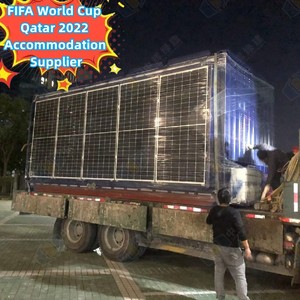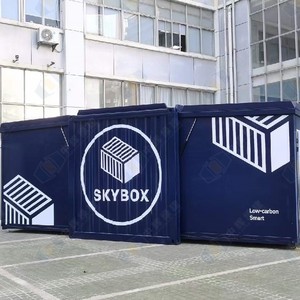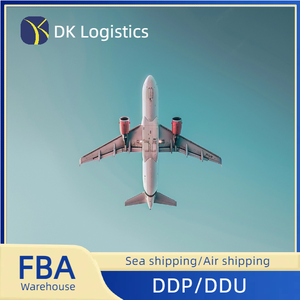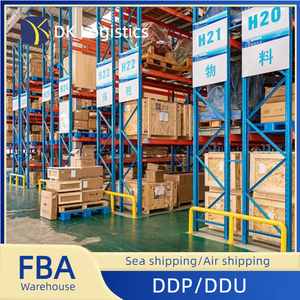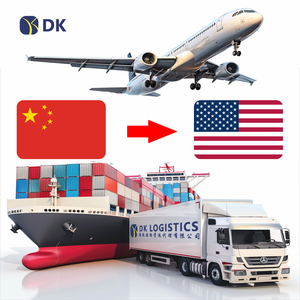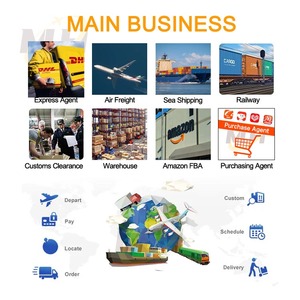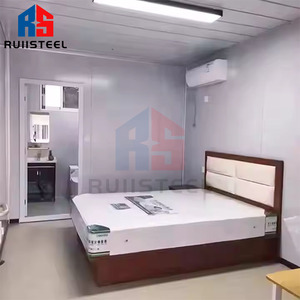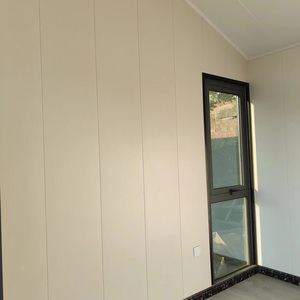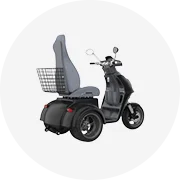Types of 30 ft Containers
The 30 ft container offers versatility for various shipping needs. Each type is engineered for specific cargo requirements, providing optimal protection and transportation efficiency.
Dry Van Container
The most common 30 ft container variety, featuring robust weatherproof steel construction. Ideal for general cargo requiring protection from environmental elements.
Best for: General merchandise, manufactured goods, and non-perishable items
High Cube Container
Modified dry van with an extra foot of vertical clearance (9'6" vs. standard 8'6"). Provides additional volume without increasing the container footprint.
Best for: Bulky, lightweight cargo requiring additional vertical space
Refrigerated Container
Temperature-controlled units with integrated cooling systems. Maintains precise temperatures between -30°C and +30°C throughout transit.
Best for: Perishable goods including fruits, vegetables, pharmaceuticals, and frozen products
Insulated Container
Features high-performance thermal barriers in walls, ceiling, and floor. Maintains stable internal conditions without active cooling systems.
Best for: Temperature-sensitive goods not requiring refrigeration
Open Top Container
Standard container with removable roof panel allowing top-loading access. Includes securing points for tarpaulin cover.
Best for: Oversized cargo, heavy machinery, and items requiring crane loading
Tunnel Container
Features double-door access at both ends, facilitating efficient loading/unloading operations and improving workflow.
Best for: Distribution centers, sequential unloading operations
Flat Rack Container
Minimalist design with floor and end walls only. Side walls are either absent or collapsible. Reinforced for securing oversized cargo.
Best for: Heavy machinery, vehicles, construction materials, and cargo exceeding standard container dimensions
Expert Tip: When selecting a specialty container type, consider not only your current cargo needs but also potential future applications. The slight premium for more versatile container types often pays dividends through extended utility.
Specifications and Technical Details
Understanding the precise specifications of 30 ft containers is essential for proper planning, loading, and transportation management.
| Specification | Standard 30 ft Container | High Cube 30 ft Container |
|---|---|---|
| External Dimensions (L×W×H) | 30' × 8' × 8'6" (9.14m × 2.44m × 2.59m) | 30' × 8' × 9'6" (9.14m × 2.44m × 2.90m) |
| Internal Dimensions (L×W×H) | 29'6" × 7'8" × 7'10" (8.97m × 2.35m × 2.38m) | 29'6" × 7'8" × 8'10" (8.97m × 2.35m × 2.69m) |
| Door Opening (W×H) | 7'8" × 7'6" (2.34m × 2.28m) | 7'8" × 8'5" (2.34m × 2.57m) |
| Tare Weight | ~5,070 lbs (2,300 kg) | ~5,290 lbs (2,400 kg) |
| Maximum Payload | ~28,800 lbs (13,068 kg) | ~28,580 lbs (12,965 kg) |
| Internal Volume | ~1,760 cubic feet (49.8 cubic meters) | ~1,980 cubic feet (56.1 cubic meters) |
Structural Materials
Most 30 ft containers are constructed from Corten steel, a specialized weathering steel alloy that forms a protective oxide layer when exposed to weather elements. This self-protecting feature minimizes maintenance requirements while providing exceptional durability.
Interior flooring typically consists of marine-grade plywood treated with insecticides and fungicides to prevent pest infestations and decay.
Security Features
Standard security elements include high-strength locking bars, tamper-evident seals, and reinforced door frames. Advanced security options available in modern containers include:
- Electronic locking systems with remote monitoring
- GPS tracking and geofencing capabilities
- Motion detection and unauthorized entry alerts
- Integrated surveillance cameras
Ventilation Systems
Ventilation in 30 ft containers is achieved through strategically positioned air vents, typically located near the upper corners of the container. These vents:
- Equalize pressure during altitude and temperature changes
- Reduce condensation through passive air circulation
- Feature water-resistant design to prevent moisture ingress
- Include mesh barriers to prevent pest entry
Essential Maintenance Practices
Proper maintenance significantly extends container lifespan and preserves cargo integrity. Implementing a regular maintenance schedule ensures optimal container performance throughout its service life.
Implement systematic inspection routines focusing on critical structural components:
- Monthly: Inspect door seals, gaskets, and locking mechanisms for proper function
- Quarterly: Examine corner posts and structural rails for deformation or damage
- Bi-annually: Check floor integrity, wall panels, and roof for punctures or water damage
- Annually: Conduct comprehensive structural assessment including weld integrity
Maintain container cleanliness to prevent corrosion and contamination:
- Use pH-neutral detergents for regular exterior washing to remove salt deposits and pollutants
- Apply pressure washing at 1,500-2,000 PSI for heavy soiling, avoiding direct spray on seals and gaskets
- Clean interior surfaces with non-toxic, low-residue cleansers appropriate for subsequent cargo
- Keep ventilation openings clear of obstructions and debris
Extend container lifespan through appropriate protective treatments:
- Apply marine-grade rust inhibitors to areas showing early oxidation
- Use elastomeric roof coatings to maintain watertight integrity
- Reapply exterior paint with zinc-rich primers when existing coatings show deterioration
- Treat wooden flooring with appropriate preservatives every 2-3 years
Proper container placement prevents structural damage and extends service life:
- Position on level, well-drained surfaces to prevent pooling water and uneven stress
- Elevate using proper dunnage or container blocks allowing at least 6" ground clearance
- Ensure all four corner posts have equal support to prevent twisting of the frame
- Maintain adequate spacing between containers for inspection access and air circulation
Important: Salt-laden environments accelerate corrosion. Containers deployed in coastal areas require more frequent maintenance cycles, with particular attention to undercarriage components and door hardware.
How to Choose the Right 30 ft Container
Selecting the optimal 30 ft container requires balancing multiple factors including intended use, budget constraints, and specific operational requirements.
While 30 ft containers offer a balance between capacity and maneuverability, they are less common than standard 20 ft and 40 ft units. Consider:
- Delivery timeframes – specialized sizes may require longer procurement periods
- Regional availability – some markets have limited 30 ft container inventories
- Space utilization – ensure the 30 ft footprint optimizes your available space
- Transport logistics – verify compatibility with local transport regulations and infrastructure
Container condition significantly impacts both price and performance:
| Classification | Characteristics | Best Use Case |
|---|---|---|
| New (One-Trip) | Pristine condition, minimal wear, often used once for import | Sensitive cargo, long-term storage, conversion projects |
| Cargo Worthy (CW) | Structurally sound, may have cosmetic issues, certified for shipping | International shipping, general storage, moderate-term use |
| Wind and Water Tight (WWT) | Weather resistant but may have dents/scratches, not certified for shipping | Domestic transportation, on-site storage, temporary structures |
| As-Is | Variable condition, may have damage, sold without guarantees | Budget projects, scrap material source, very short-term use |
Assess security features based on cargo value and exposure risks:
- Verify door seal integrity and locking mechanism robustness
- Consider additional security hardware for high-value cargo
- Evaluate container history for previous damage or repairs
- Check compatibility with your existing security systems and protocols
Different loading/unloading needs require specific container configurations:
- Standard end loading – conventional rear doors are sufficient
- Side access – consider containers with side opening options
- Top loading – open-top containers allow crane loading of oversized items
- Multiple access points – tunnel containers with double-end doors improve workflow
Evaluate the container's suitability for modifications:
- Structural integrity – ensure the container can support planned alterations
- Material composition – some modifications require specific base materials
- Regulatory compliance – check local codes for modified container installations
- Future adaptability – consider whether the container can evolve with changing needs
Pro Tip: Request the container's CSC plate information before purchase. This data includes manufacturing date, approval reference, and structural specifications. Valid CSC certification is essential for international shipping and indicates proper maintenance history.
DIY and Replacement Guide
Whether replacing an existing container or undertaking modifications, proper planning and execution are crucial for successful outcomes. Follow this systematic approach:
1. Planning Phase
Comprehensive planning creates the foundation for successful container projects:
- Budget Development - Create detailed cost estimates including purchase, transportation, site preparation, and modifications
- Container Selection - Determine optimal size, condition, and type based on intended use
- Timeline Construction - Establish realistic schedules accounting for procurement delays and weather considerations
- Regulatory Compliance - Research local permits, zoning requirements, and building codes
- Resource Allocation - Identify required equipment, materials, and specialized skills
2. Preparation Phase
Proper site preparation ensures smooth container delivery and installation:
- Site Selection - Choose location with adequate access for delivery vehicle (typically 50'+ clearance)
- Foundation Preparation - Create level base using concrete pad, gravel bed, or engineered footings
- Access Route Verification - Confirm delivery path is clear of overhead obstacles and has adequate turning radius
- Utility Considerations - Plan for electrical, water, and drainage requirements if applicable
- Equipment Staging - Arrange for appropriate lifting equipment (crane, forklift, etc.)
3. Transport and Replacement
Coordinating logistics ensures efficient container delivery and placement:
- Transport Selection - Choose appropriate carrier with experience handling containers
- Delivery Coordination - Schedule specific delivery window and confirm access requirements
- Placement Precision - Direct precise positioning during offloading to minimize adjustments
- Inspection Process - Conduct thorough assessment immediately upon delivery
- Anchoring Methods - Secure container according to local requirements and intended use
Safety Warning: Container positioning and modification involve significant safety risks. Never stand beneath suspended containers during lifting operations. Always use appropriate lifting equipment rated for container weight. Consider consulting with structural engineers before making significant modifications.
Frequently Asked Questions
The capacity varies significantly based on part type, size, and packaging efficiency:
- Small components (spark plugs, sensors, fuses): Many thousands depending on packaging
- Medium parts (alternators, starters, radiators): Approximately 1,000-1,500 units
- Larger components (doors, hoods, bumpers): 200-300 units with proper stacking
- Complete engines/transmissions: 40-60 units depending on size and arrangement
Optimizing space utilization through professional packing and appropriate dunnage can increase capacity by 15-25% over standard loading practices.
A standard 30 ft container has a maximum payload capacity of approximately 28,800 lbs (13,068 kg). The combined weight (container plus cargo) should not exceed 33,870 lbs (15,368 kg) to comply with most international shipping regulations.
Important considerations regarding weight limits include:
- The container's tare weight (empty weight) is approximately 5,070 lbs (2,300 kg)
- Weight distribution should be balanced with 60% of weight in the center portion
- Local road regulations may impose additional weight restrictions during transport
- High cube variants may have slightly lower payload capacity due to increased tare weight
Yes, 30 ft containers can transport hazardous materials when properly prepared and certified. Requirements include:
- Container Certification - Must be inspected and approved for hazardous cargo
- Proper Placarding - Container must display appropriate hazard diamond placards on all four sides
- Manifest Documentation - Detailed hazardous materials declarations must accompany shipment
- Packaging Requirements - Hazardous materials must be packaged according to applicable regulations (IMDG, DOT, etc.)
- Segregation Rules - Certain hazardous materials cannot be shipped together
Always consult with hazardous materials specialists and comply with international shipping regulations (IMDG Code) and local transport requirements when shipping dangerous goods.
Yes, specialized 30 ft refrigerated containers ("reefers") are designed specifically for temperature-controlled transportation. These units feature:
- Integrated refrigeration systems capable of maintaining temperatures from -30°C to +30°C
- Enhanced insulation with polyurethane foam walls approximately 3" thick
- Digital temperature controls with remote monitoring capabilities
- Interior air circulation systems ensuring uniform temperature distribution
- T-floor grating to optimize airflow beneath cargo
- Independent power systems or external power connections
Refrigerated containers are ideal for perishable goods including produce, meat, dairy, pharmaceuticals, and other temperature-sensitive products requiring precise climate control throughout the supply chain.

